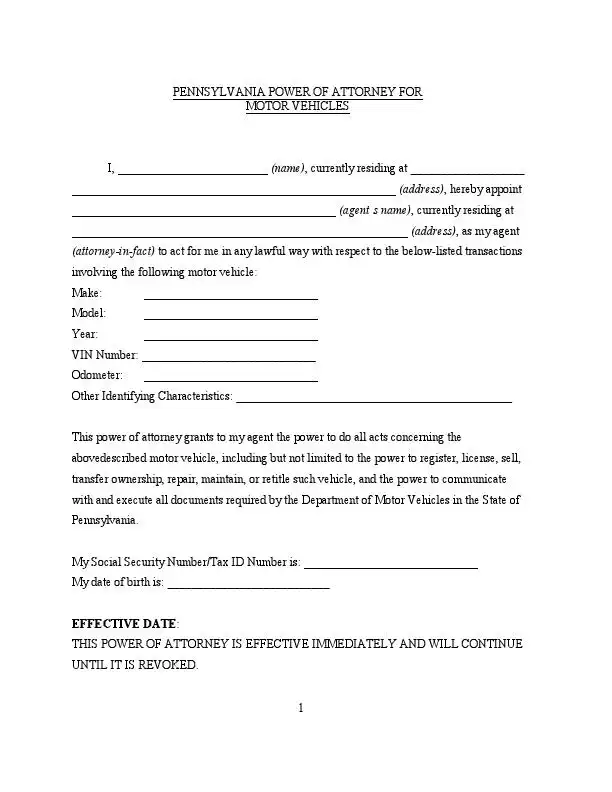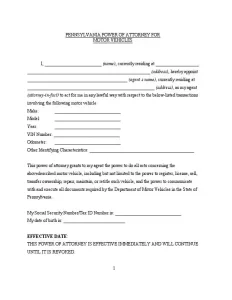Pennsylvania Motor Vehicle Power of Attorney Form
The Pennsylvania vehicle power of attorney is an essential legal document that authorizes an agent to handle matters related to the title and registration of a motor vehicle on behalf of the principal. This delegation of authority is particularly useful in situations where the vehicle owner cannot be present to handle these transactions.

Build Your Document
Answer a few simple questions to make your document in minutes
Save and Print
Save progress and finish on any device, download and print anytime
Sign and Use
Your valid, lawyer-approved document is ready
Under Pennsylvania law, specific requirements must be met for the motor vehicle POA to be considered valid:
- The form must be fully completed and signed by the principal, who is the vehicle owner.
- The principal’s signature on the form must be notarized to verify the signer’s identity and acknowledge that the signature was made willingly and without duress.
- It should accurately state the VIN, make, model, and vehicle year, ensuring all details match those on official documents.
The principal and the agent must understand the scope of the authority the POA grants. A power of attorney template can also be customized to grant an agent specific or broad powers over your financial or health-related decisions to address various legal needs. If you need Pennsylvania POA forms, there are various options available online.
Pennsylvania Consolidated Statutes Title 75 (Vehicles), Section 1961 addresses the fee for processing a secure power of attorney for odometer disclosure when not accompanied by an application for title. This statute ensures that the agent’s actions are legally binding.
Pennsylvania Motor Vehicle Power of Attorney Form Details
| Document Name | Pennsylvania Motor Vehicle Power of Attorney Form |
| State Form Name | None |
| Relevant Link | Pennsylvania Department of Transportation |
| Avg. Time to Fill Out | 15 minutes |
| # of Fillable Fields | 25 |
| Available Formats | Adobe PDF |
Filling Out Pennsylvania Vehicle POA
When filling out the Pennsylvania motor vehicle power of attorney form, it’s important to provide accurate and complete information to authorize an agent to handle your vehicle-related matters legally.
1. Principal and Agent Information
Begin by reading the entire form to understand the scope of authority you are granting to your agent. Ensure you have all the necessary information about your vehicle and agent before completing the form. Then, enter your full legal name and residential address where indicated. Similarly, provide the name and residential address of the person you designate as your agent (attorney-in-fact).
2. Vehicle Details
Fill in the specific details of the motor vehicle that the agent will handle. This includes the vehicle’s make, model, year, VIN, and odometer reading at the time of form completion. Also, fill in any other identifying characteristics that might be relevant.
3. Powers Granted
Review the powers you grant to your agent, including the authority to register, license, sell, transfer ownership, repair, maintain, or retitle the vehicle. Confirm that these powers adequately cover your needs.
4. Personal Information
Include your Social Security Number or Tax ID Number and date of birth in the designated spaces to comply with identification requirements.
5. Effective Date and Term
Specify the effective date from which the power of attorney will start. Note that this power of attorney will continue until you revoke it.
6. Successor Attorney-in-Fact
If you wish to appoint a successor attorney-in-fact in case your primary agent cannot serve, provide their name and address.
7. Sign and Date
Sign and date the form in the presence of a notary public. Ensure the notary completes the acknowledgment section, which verifies your identity.
8. Notarization
The form must be notarized to validate your signature. The notary will fill out the state, county, and date and affix their seal on the form. Once all sections are completed and the form is notarized, your Motor Vehicle Power of Attorney will be legally binding and can be used by your agent to carry out your specified duties. Keep copies of this important document for your records and provide an original copy to your agent.
